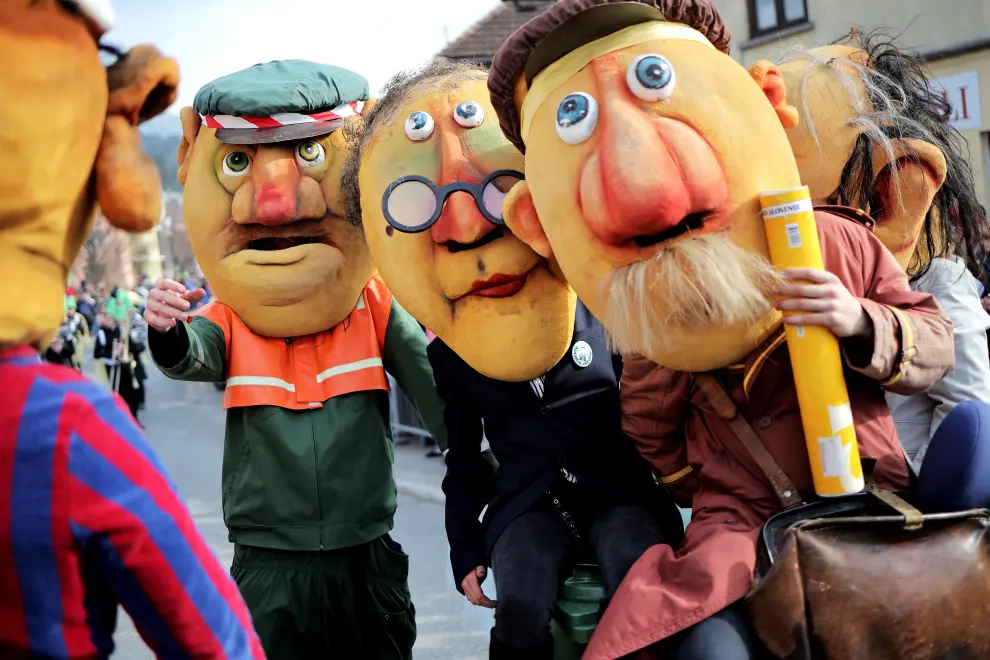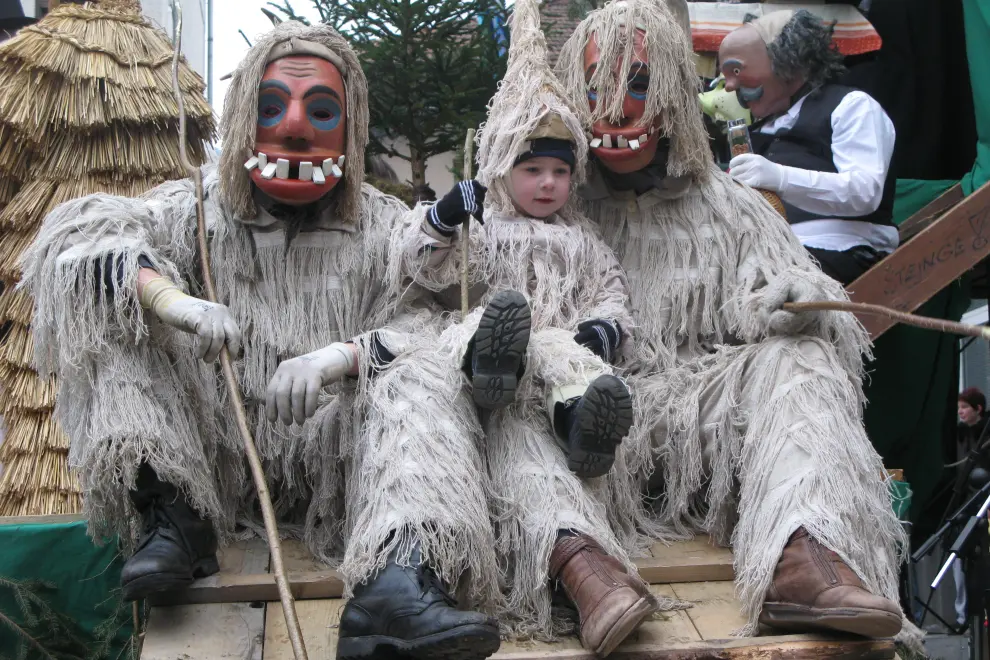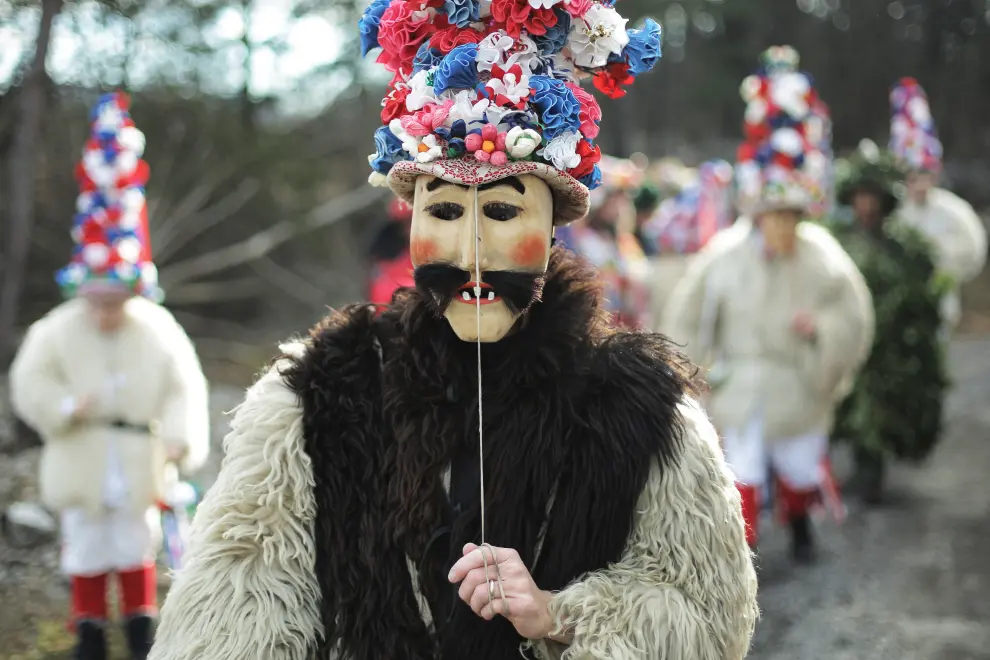Let the carnival revelry begin
Carnival parade in Ptuj.
Photo: Nebojša Tejić/STA
File photo
Horned creatures, dragons, folklore characters and floats mocking politicians will join in the revelry in towns and villages across Slovenia as carnival festivities are back in full swing this year after a Covid hiatus.
While some of the traditional festivities and rites began well ahead, the Shrovetide ceremonies will culminate this weekend to ward off evil spirits and announce the end of winter. The events in Ptuj, Cerknica and Cerkno are expected to draw the biggest crowds.
Kurent reigns supreme in Ptuj
Dominated by the traditional local sheepskin costume, the Kurent, the carnival in Ptuj in the north-east of the country is Slovenia's biggest and most popular event.
Held for the 63th year running, the festival got under way on 11 February as the mayor handed over to the carnival prince to let him preside over a parade of traditional costumed figures.
Some 2,500 masks from Slovenia and abroad will converge on what is Slovenia's oldest city on Shrove Sunday and by the time festivities end on Ash Wednesday the festival will have featured some 4,000 participants from ten countries, which the organizers say makes their event one of the biggest such in Europe.
Carrying big furry headgear with cow horns, feathers and colourful ribbons, and big cow bells around their waists, the Kurents make an impressive sight. They brandish their wooden sticks and ring their bells loudly to driive away all things evil and bring happiness to those they visit.
The door-to-door rounds made by the Kurenti from Candlemas to Ash Wednesday are part of the UNESCO list of intanglible cultural heritage.
The Kurenti are a regular feature at other carnivals around the country and have become a mascot of sorts, often making an appearance at sporting and other events.

Butalci in Cerknica. Photo: STA
Dimwits, dragon and witches in Cerknica
The carnival in Cerknica, in south central Slovenia, draws on the local mythology of witches from Mount Slivnica and monsters from Lake Cerknica.
The Butalci - slow-witted characters meant as a caricature of Slovenians - will replace the mayor on Fat Thursday at a ceremony known as "the sawing of the old woman".
The best known local carnival figures are Uršula the Witch and Jezerko the Dragon, which will be part of Sunday's procession, this year focusing on dragons.
Preparations for the carnival started as early as October. "The dragon is our largest figure and it took us almost eight hours just to paint it," David Petkovič from the Cerknica Carnival Association told the STA.
Almost 50 years old, the association is known for its large masks rather than traditional costumes typical for some other parts of Slovenia. They have so many they keep them in a hangar.
The festival wraps up with the burial of the Pust on Ash Wednesday, when the Shrove man is burnt and thrown into the river in what is believed to be the oldest moving street Shrovetide show on Slovenian soil.
Mock trial in Cerkno
A similar fate awaits the Pust in Cerkno in the west of the country, but not before he is put on trial and convicted to death for all the bad things that have happened locally and the world at large in the past year.
Apart from a jury and a judge, the whole affair involves a cast of 25 different costumed characters, known as the Laufarji or Runners, named so after the figure who is always running around.
Each member of the family wears one of the distinctive costumes and masks carved from lime tree wood. Some of these are archaic, originating from pagan times, while others are new additions.
These represent either a local trade or craft - such as the innkeeper - or display certain character traits or afflictions - like the Scabby Man or the Drunk and his wife.
The festivities begin the first Sunday after the New Year's, when the first Laufar makes his appearance in the streets. Every Sunday more figures appear, so that the group is complete on the Sunday before Ash Wednesday.
In the run-up to the festival, the Laufarji make their rounds in Cerkno and nearby villages with good wishes for health and an abundant harvest, the typical invocation being that "the turnip may be bigger".

Laufarji, Cerkno. Photo: STA
Tradition both old and rich
Pust festivities - as carnival festivities are called in Slovenian - originate in ancient pagan times. Slovenian masks are very picturesque and Pust customs unique in many ways.
The Brkini, in the south-west of the country, is known for the Škoromati, a group of masks featuring sheepskin costumes, tall colourful hats and ribbons.
By written records these are the oldest Shrovetide masks in Slovenian lands with the earliest records dating back to 1340 when the local council of Cividale del Friuli responsible for the area banned Škoromati outfit (in habitu scaramatta) from the streets unless the bearer was able to provide an authorisation from the city council.

Škoromati, Brkini. Photo:STA
Šoštanj in the north has figures representing the wives of leather craftsmen who carry their husbands home from a pub in a basket, the sort of a man carrying woman character that can be seen in many other parts of the country. This year the town will host its 70th carnival festival.
The biggest Shrovetide event in Gorenjska, in the north-west, is organised in Šenčur near Kranj, where the local Godlarji Association often mocks politicians. This year, they have made figures of the prime minister, president and the parliamentary speaker.
In the area of Celje, Mozirje hosts one of the best known carnivals, which boats a tradition over a century long. Pustnaki will take over the town on Shrove Tuesday.
Carnival festivities are also held in large urban centres. Ljubljana will host the Dragon's Festival on 18 February to bringi together various groups of traditional and modern-time figures.
It has been a custom for kids in Slovenia, in particular in rural areas, to go from door to door on Shrove Tuesday or at the weekend before it to get treats, similar like kids do in the US for Halloween.
And there is no Pust in Slovenia without doughnuts or krofi, which are traditionally round, filled with jam and topped with powdered sugar.


